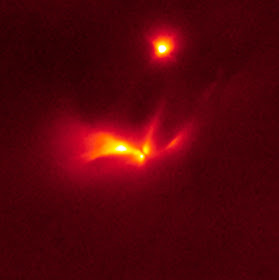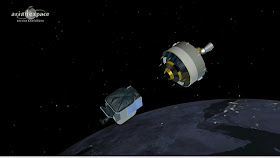Asteroid Watch.
Feb. 4, 2013
Artist's view of asteroids passing Earth
Small near-Earth asteroid 2012 DA14 will pass very close to Earth on February 15, so close that it will pass inside the ring of geosynchronous weather and communications satellites. NASA's Near-Earth Object Program Office can accurately predict the asteroid's path with the observations obtained, and it is therefore known that there is no chance that the asteroid might be on a collision course with Earth. Nevertheless, the flyby will provide a unique opportunity for researchers to study a near-Earth object up close. Here are the facts about the safe flyby of Earth of asteroid 2012 DA14 -- a record close approach for a known object of this size.
Record-Setting Asteroid Flyby
An overview of near-Earth objects with emphasis on the upcoming close approach of asteroid 2012 DA14.
Asteroid 2012 DA14 is a small near-Earth object – approximately 150 feet (45 meters) in diameter. On Feb. 15, 2013, the asteroid will pass by our planet at a remarkably close distance, but the asteroid’s path is understood well enough that there is no chance of a collision with the Earth.
Asteroid 2012 DA14 will be closest to Earth on Feb. 15 at approximately 19:24 UTC (2:24 p.m. EST/11:24 a.m. PST). This time may change by a minute or two as the asteroid is tracked on its approach and predictions are refined.
At the time of closest approach, the asteroid will be over the eastern Indian Ocean, off Sumatra -- approx. latitude: -6 deg South. / longitude: 97.5 deg East.
Graphic depicts the trajectory of asteroid 2012 DA14 on Feb 15, 2013. In this view, we are looking down from above Earth's north pole. Image credit: NASA/JPL-Caltech.
Asteroid 2012 DA14 will be only about 17,200 miles (27,700 kilometers) above Earth's surface at the time of closest approach on Feb 15, 2013. This distance is well outside Earth's atmosphere, but it is inside the belt of satellites in geostationary orbit, which is located 22,200 miles (35,800 kilometers) above Earth’s surface. The close-approach distance is only about one-tenth the distance between Earth and moon. Another way to express the distance between asteroid and Earth at time of closest approach is 4.4 Earth radii from Earth’s surface – or about twice the diameter of the Earth.
The orbit of asteroid 2012 DA14 is well understood – it will not come any closer than 17,150 miles (27,650 kilometers) above Earth's surface during its flyby on Feb 15, 2013.
The asteroid’s orbit around the sun is roughly similar to that of Earth, and it makes relatively close approaches to our planet’s orbit twice per orbit. But, the 2013 flyby is by far the closest the asteroid will approach our planet for many decades. The next notable close approach to Earth will be on February 16, 2046, when the asteroid will pass no closer than 620,000 miles (1,000,000,000 kilometers) from the center-point of Earth.
The flyby of asteroid 2012 DA14 is the closest ever predicted Earth approach for an object this large.
Graphic depicts the trajectory of asteroid 2012 DA14 during its close approach, as seen edge-on to Earth's equatorial plane. The graphic demonstrates why the asteroid is invisible to northern hemisphere observers until just before close approach: it is approaching from "underneath" our planet. On the other hand, after close approach it will be favorably placed for observers in the northern hemisphere. Image credit: NASA/JPL-Caltech.
Asteroid 2012 DA14's will be within the Earth/moon system for about 33 hours. Its orbit will bring it within the Earth/moon system (approach within one lunar distance, 237,000 miles of the Earth) on Feb. 15 at about 0300 UTC (7 p.m. PST on Thursday, Feb. 14). The asteroid will exit the Earth/moon system on Feb. 16 at about 1200 UTC (4 a.m. PST).
Asteroid 2012 DA14 is currently estimated to be about 150 feet (45 meters) across and has an estimated mass of about 130,000 metric tons. If radar observations of this asteroid are successful, we might have a more accurate estimate of the asteroid’s size after its close approach.
Asteroid 2012 DA 14 is traveling at about 17,450 miles per hour (28,100 kilometers per hour), or 4.8 miles per second (7.82 kilometers per second) relative to Earth. Scientists believe there are approximately 500,000 near-Earth asteroids the size of 2012 DA14. Of those, less than one percent have been discovered.
Scientists at NASA's Near-Earth Object Program Office in Pasadena, Calif. estimate that an asteroid the size of 2012 DA14 flies this close every 40 years on average and that one will impact Earth, on average, about once in every 1,200 years.
Asteroid 2012 DA14 to Safely Pass Earth
Asteroid 2012 DA14 to Safely Pass Earth. The flyby of asteroid 2012 DA14 on Feb. 15, 2013, will be the closest known approach to Earth for an object its size. Credit: NASA/JPL-Caltech.
Is there a chance that asteroid DA14 will collide with one or more satellites?
There is very little chance that asteroid 2012 DA14 will impact a satellite or spacecraft. Because the asteroid is approaching from below Earth, it will pass between the outer constellation of satellites located in geosynchronous orbit (22,245 miles/35,800 kilometers) and the large concentration of satellites orbiting much closer to Earth. (The International Space Station, for example, orbits at the close-in altitude of 240 miles/386 kilometers.). There are almost no satellites orbiting at the distance at which the asteroid will pass.
Asteroid 2012 DA14 will not impact Earth, but if another asteroid of a size similar to that of 2012 DA14 (about 150 feet across) were to impact Earth, it would release approximately 2.5 megatons of energy in the atmosphere and would be expected to cause regional devastation.
A comparison to the impact potential of an asteroid the size of 2012 DA14 could be made to the impact of a near-Earth object that occurred in 1908 in Tuguska, Siberia. Known in the asteroid community as the "Tunguska Event," this impact of an asteroid just slightly smaller than 2012 DA14 (approximately 100 – 130 feet/30-40 meters across) is believed to have flattened about 750 square miles (1,200 square kilometers) of forest in and around the Podkamennaya Tunguska River in what is now Krasnoyarsk Krai, Russia.
Artist's view of the Podkamennaya Tunguska River asteroid impact
As there is no chance of impact, there is nothing that needs to be done about the asteroid. However, the flyby of 2012 DA14 is a great opportunity for science. NASA's Goldstone Solar System Radar, located in California's Mojave Desert, will observe the asteroid on Feb. 16, 18, 19 and 20. Due to the asteroid's small size, the radar images generated are expected to be no more than a few pixels across. It will also be observed by numerous optical observatories worldwide to attempt to determine its spin rate and composition.
During the closest approach, and dependant on local weather, the asteroid will be visible from parts of Europe, Africa and Asia. The asteroid will appear to be moving relatively quickly as it crosses the sky from the south to the north.
The NASA Near Earth Object Observation (NEOO) Program detects and tracks asteroids and comets passing close to Earth using both ground- and space-based telescopes. The network of projects supported by this program, commonly called "Spaceguard," discovers these objects, characterizes a subset of them and plots their orbits to determine if any could be potentially hazardous to our planet.
Asteroid 2012 DA14 was discovered by the La Sagra Sky Survey operated by
the Astronomical Observatory of Mallorca in Spain on Feb. 23, 2012.
The asteroid was about 2.7 million miles (4.3 million kilometers)
distant when it was detected. Their observations were reported to the
NASA funded Minor Planet Center, operated by the Smithsonian
Astrophysical Observatory for the International Astronomical Union,
where all observations from observatories worldwide are combined to
maintain the database on all known asteroids and comets in our solar
system.
Additional information:
NASA's Science News - Record Setting Asteroid Flyby:
http://science.nasa.gov/science-news/science-at-nasa/2013/28jan_2012da/
Asteroid Watch: For more information about asteroids and near-Earth objects, visit:
http://www.jpl.nasa.gov/asteroidwatch and
http://www.nasa.gov/asteroid . Updates about near-Earth objects are also available by following AsteroidWatch on Twitter at
http://www.twitter.com/asteroidwatch .
Near-Earth Object Program Office:
http://neo.jpl.nasa.gov/
Images, Videos, Text, Credits: NASA / JPL-Caltech.
Cheers, Orbiter.ch








































.jpg)









